After a decade of writing explanations, I’ve simplified the strategy I use to get new concepts to click.
Make explanations ADEPT: Use an Analogy, Diagram, Example, Plain-English description, and then a Technical description.
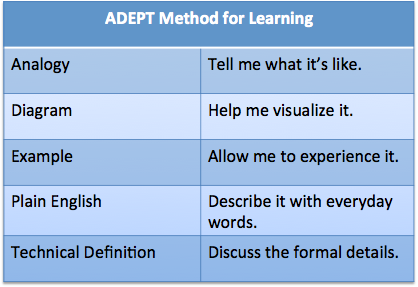
Here’s how to teach yourself a difficult idea, or explain one to others.
Analogy: What Else Is It Like?
Most new concepts are variations, extensions, or combinations of what we already know. So start there!
In our decades of life, we’ve encountered thousands of objects and experiences. Surely one of them is vaguely similar to this new topic and can be the starting point.
Here’s an example: Imaginary numbers. Most lessons introduce them in a void, simply saying “negative numbers can have square roots too.”
Argh. How about this:
- Negative numbers were distrusted until the 1700s: How could you have less than nothing?
- We overcame this by realizing numbers could exist on a number line, allowing us to move forward or backward from zero.
- Imaginary numbers express the idea that we can move upwards and downwards, or rotate around the number line.
Instead of just going East/West, we can go North/South too – or even spin around in a circle. Neat!
Analogies are fuzzy, not 100% accurate, and yet astoundingly useful. They’re a raft to get across the river, and leave behind once you’ve crossed.
Diagram: Engage That Half Of Your Brain
We often think diagrams are a crutch if you aren’t macho enough to directly interpret the symbols. Guess what? Academic progress on imaginary numbers took off only after the diagrams were made!
Favor the easiest-to-absorb explanation, whether that comes from text, diagram, or interpretative dance. From there, we can work to untangle the symbols.
So, here’s a visualization:
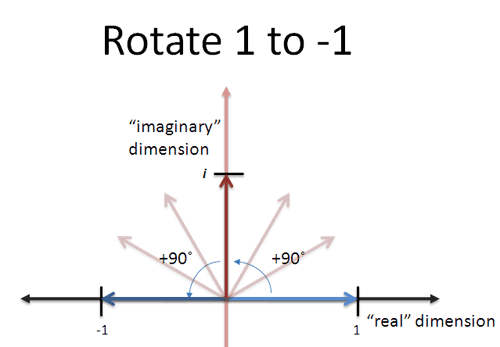
Imaginary numbers let us rotate around the number line, not just move side-to-side.
Starting to get a visceral sense for what they can do, right?
Half our brain is dedicated to vision processing, so let’s use it. (And hey, maybe for this topic, twirling around in an interpretative dance would help.)
Example: Let Me Experience The Idea
Oh, now’s our chance to hit the student with the fancy terminology, right?
Nope. Don’t tell someone the way things are: let them experience it. (How fun is hearing about the great dinner I had last night? The movie you didn’t get to see?)
But that’s what we do for math. “Someone smarter than you thought this through, found out all the cool connections, and labeled the pieces. Memorize what they discovered.”
That’s no fun: let people make progress themselves. Using the rotation analogy, what happens after 4 turns?
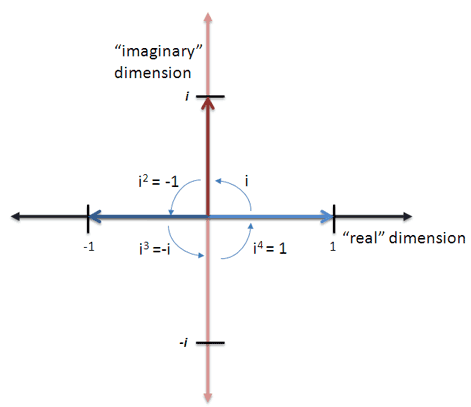
How about 2 turns? 4 turns clockwise?
Plain-English Description: Use Your Own Words
If you genuinely experienced an idea, you should be excited to describe it:
- Imaginary numbers seem to point North, and we can get to them with a single clockwise turn.
- Oh! I guess they can point South too, by turning the other way.
- 4 turns gets us pointing in the positive direction again
- It seems like two turns points us backwards
These are all correct conclusions, just not yet written in the language of math. But you can still reason in plain English!
Technical Description: Learn The Formalities
The final step is to convert our personal understanding to the formal notation. It’s like sharing a song you’ve made up: you can hum it to yourself, but need sheet music for other people to use.
Math is the sheet music we’ve agreed upon to share ideas. So, here’s the technical terminology:
- We say i (lowercase) is 1.0 in the imaginary dimension
- Multiplying by i is a 90-degree counter-clockwise turn, to face “up” (here’s why). Multiplying by -i points us South
- It’s true that starting at 1.0 and taking 4 turns puts us at our starting point:
![]()
And two turns points us negative:
![]()
which simplifies to:

so
![]()
In other words, i is “halfway” to -1. (Square roots find the halfway point when using multiplication.)
Starting to get a feel for it? Just spitting out “i is the square root of -1” isn’t helpful. It’s not explaining, it’s telling. Nothing was experienced, nothing was internalized.
Give people the chance to make an idea their own.
The Mental Checklist
I used to be satisfied with a technical description and practice problem. Not anymore.
ADEPT is a checklist of what I need to feel comfortable with an idea. I don’t think I’ve actually learned a topic unless I have a metaphor that ties everything together. Here’s a few places to look:
- Analogy – ?
- Diagram – Google Images
- Example – Khan Academy for practice problems
- Plain-English – Forums like /r/math or Math Overflow
- Technical – Wikipedia or MathWorld
Unfortunately, there aren’t many resources focused on analogies, especially for math, so you have to make your own. (This site exists to share mine.)
Modifying the Learning Order
It seems logical to assume we can present facts in order, like transmitting data to a computer. But who actually learns like that?
I prefer the blurry-to-sharp approach to teaching:
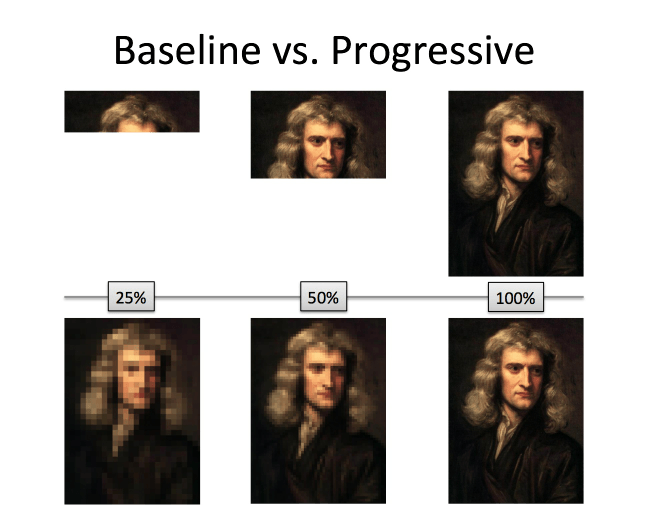
Start with a rough analogy and sharpen it until you’re covering the technical details.
Sometimes, you need to untangle a technical description on your own, so must work backwards to the analogy.
Starting with the technical details:
- Can you explain them in your own words?
- Can you solve an example problem, describing the steps in your own words?
- Can you create a diagram that represents how the concept fits together for you?
- Can you relate the concept to what you already know?
With this initial analogy, layer in new details and examples, and see if it holds up. (It doesn’t need to be perfect, but iterate.)
If we’re honest, we’ll admit that we forget 95% of what we learn in a class. What sticks? A scattered analogy or diagram. So, make them for yourself, to bootstrap the rest of the understanding as needed.
In a year, you probably won’t remember much about imaginary numbers. But the quick analogy of “rotation” or “spinning” might trigger a flurry of recognition.
The Goal: Explanations That Actually Work
I’m wary of making a contrived acronym, but ADEPT does capture what I need to internalize a new concept. Let’s stop being shy about thinking out loud: does a fact-only presentation really work for you? What other components do you need? I have a soft, squishy brain that needs the connecting glue, not just data.
Scott Young uses the Feynman Technique to explain concepts in everyday words and work backwards to an analogy and diagram. (Richard Feynman was a world-class expositor and physicist, and one of my teaching heroes.)
Beyond any technique, raise your standards to find (or create) explanations that truly work for you. It’s the only way to have concepts stick.
Happy math.
Bonus: BE ADEPT
“BE” is a nice prefix for the style to use when teaching:
Brevity is beautiful.
Empathy makes us human. Use your natural style, relate to common experience, and anticipate questions in your explanation.
I’ve yet to complain that a lesson respected my time too much, or related too well to how I thought.
Appendix: ADEPT Summaries
ADEPT is like a nutrition label for an explanation: what are the key ingredients?
| Concept | Euler’s Formula |
|---|---|
| Analogy | Imaginary numbers spin exponential growth into a circle. |
| Diagram |  |
| Example | Let’s figure out the value of 3^i. (It’s on the unit circle.) |
| Plain-English | Raising an exponent to an imaginary power spins you on the unit circle. The same destination can be written with polar (distance and angle) or rectangular coordinates (real part and imaginary part). |
| Technical |
| Concept | Fourier Transform |
|---|---|
| Analogy | Like filtering a smoothie into ingredients, the Fourier Transform extracts the circular paths within a pattern. |
| Diagram | Smoothie being filtered:  |
| Example | Split the sequence (4 0 0 0) into circular components:  |
| Plain-English / Technical |  |
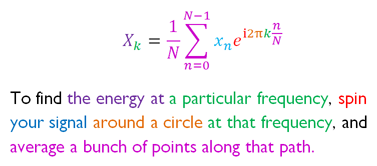
| Concept | Distributed Version Control |
|---|---|
| Analogy | Distributed Version Control is like sharing changes to a group shopping list with your friends. |
| Diagram / Example |  |
| Plain-English | We check out, check in, branch, and share differences (“diffs”). |
| Technical | git checkout -b branchname git diff branchname |
Combine ingredients with your own style. Steps might merge, but shouldn’t be skipped without a good reason (“Zombies coming, no time for biochem, use this serum for the cure.”). The site cheatsheet has a large collection of analogies.
Other Posts In This Series
- Developing Your Intuition For Math
- Why Do We Learn Math?
- How to Develop a Mindset for Math
- Learning math? Think like a cartoonist.
- Math As Language: Understanding the Equals Sign
- Avoiding The Adjective Fallacy
- Finding Unity in the Math Wars
- Brevity Is Beautiful
- Learn Difficult Concepts with the ADEPT Method
- Intuition, Details and the Bow/Arrow Metaphor
- Learning To Learn: Intuition Isn't Optional
- Learning To Learn: Embrace Analogies
- Learning To Learn: Pencil, Then Ink
- Learning to Learn: Math Abstraction
- Learning Tip: Fix the Limiting Factor
- Honest and Realistic Guides for Learning
- Empathy-Driven Mathematics
- Studying a Course (Machine Learning) with the ADEPT Method




Leave a Reply
44 Comments on "Learn Difficult Concepts with the ADEPT Method"
I had taken the Learning How to Learn course, Kalid, and was happy but not surprised to see you show up as the windup interview. I’m glad to see you offer it on this site, as well. ADEPT is a great tool!
Thanks Evan! I was really honored and humbled to be able to share my thoughts with the class. Glad the method’s clicking for you =).
Hi. I recently discovered your absolutely marvelous site. I am struggling on note taking technique right now. What tools did you use on drawing those diagrams? They looked great!
Hi Indra, thanks so much. I use PowerPoint to draw all the diagrams: there’s many nice default formatting styles that look very clean out of the box. Here’s an example:
/examples/graphics/Exponential-growth.pptx
Maybe I’ll do a mini tutorial on PowerPoint graphics one day :).
Hello Khalid,
Thank you! Much appreciated! Richard Feynman is my Guru too! His ‘lectures on Electromagnetism’ were recommended as our text book for one of our courses. Reading the lectures was itself so enlightening! I would go back and read it all over again like a favorite novel. I wonder what it would feel like to have been his student.
Thanks again, wonderful post.
Abigail
You are “the man!” Please, keep on writing! You put many so called college “math professors” to shame! It’s clear you have a Passion for what you do, where most of the phony Profs are merely there for the paycheck, no wonder this country (US) lacks serious engineering talent; it’s our own fault for tolerating much too powerful teacher unions where tenure is a ticket to do whatever the hell one pleases, good for the profs, BAD for the students who PAY their salaries.
Dear Khaled- I liked the diagram which explains negative numbers with a circle along which a number can travel, from plus 1 through zero, via i, than on below the line, where I lost you a bit. But I was wondering, instead of a circle, what if we represented the journey of a number with a sphere? Obviously cannot be shown easily in two dimensions. In a circle, we divide up the possible points into degrees,minutes and seconds. In a sphere, how do we divide up the much greater number of possible points?
[…] important thing that you have to learn is to focus on the current task that you do. Try to concentrate on it so that you will be able to […]
[…] Really like ADEPT Method […]
Brilliant stuff thanks! It confirms what I try to do on my best days, and then some! It’ll be a really useful format to consider when I’m figuring out how to introduce new topics, especially for A-level.
I really appreciate your skill and style Khaled. Thank you for another great lesson in process.
@Abigail: Thank you! I’ve been meaning to see more of Feynman’s lectures, especially since they’ve been opened up (http://research.microsoft.com/apps/tools/tuva/index.html#data=3%7Cd71e62e2-0b19-4d82-978b-9c0ea0cbc45f%7C%7C). I wish I could have been a student and dug into the intuitions he had as well.
@mj: Thanks for the encouragement =). Yes, unfortunately there’s a pressure on professors to publish or perish (not teach or perish). I think positions should deb split into research-only and teaching-only. It’s like forcing a chef to be a waiter, or a writer to be an actor too.
@Jonathan: Great question. As you suspected, we might want to move a number around in a 3d sphere, vs. a 2d circle. There are special numbers which have been invented to go to higher dimensions (called quaternions – which are actually 4d) and I hope to do some follow ups on them.
You can also skip labeling the individual dimensions, and start giving the angles you want (go forward 1.0, rotate 30-degrees in this direction, then rotate 45 degrees up, etc.). Part of math is figuring out the right system that helps describe what you want, or inventing a better one :).
@Anthony: Awesome, glad it’ll be helpful. It’s now my mental checklist that I have to fill out before I’m satisfied I really understood a topic.
@Mike: Thanks!
Hello Kalid,
How to explain that the sum of all positive integers is -1/12.
Will BE ADEPT help?
This way you put all your work in one single post! I really like this ADEPT approach which I think should be adopted by serious learners who want to grasp the thing and not just memorize a bunch of methods and formulae.
I am a big admirer of great physicist Richard Feynman and definitely your approach matches his style. Keep up the good work.
Harish Dobhal
@Nandeesh: Yep, in that case you might want to look at the existing proofs and work backwards. When explaining something to others, you start with the analogy and go forward, but with an existing result, you have to build up the plain-English, diagrams, etc. yourself.
@Harish: Thank you!
I found this site when I was searching for a better explanation of imaginary numbers for myself and my students. WOW! this is how I like to teach. Sometimes I hit the mark, sometimes I don’t, but with your site, I think the bulls-eye just got a whole lot bigger. I am definitely going to hang out here a lot.
Hi Tony! Glad you found the site, that’s great to hear. I love sharing ideas & material with other teachers, feel free to poke around. Welcome aboard =).
[…] ADEPT Topic […]
[…] questions. My booklet, All About Energy, makes for a nice introduction. Taking inspiration from BetterExplained’s ADEPT method of introducing a concept, I’ve filled the booklet with analogies, pictures and some real facts […]
Though I am usually not a phan of phorced acronyms ADEPT has actually been working for me as I try to explain just what and how it is that better explained explains. Keep up the awesome.
Thanks Mark =). I’d been struggling to describe the difference myself (I think I got lucky that I didn’t have to search for more letters).
Great post! Is there some place on this website (now or in the future) where readers can contribute their own ADEPT explanations? I’m sure many of your readers have great explanations and are willing to share.
Thanks Eric! I have a few projects underway to help make the site more collaborative — stay tuned :).
[…] Cosines” gets you thinking about the mechanics of the formula, not what it means. Part of my learning strategy is rewording ideas into sense that make sense to […]
your work is so great! gives so many aha moment , thanks a lot!
Dear Kalid,
You are doing a great job by making difficult to understand subjects intuitive and colorful. I wish my professors had done this.
Spending adept like methods to learn the interesting subjects in college days, took the time away from understanding the complex ones. Reading your articles give the joy of understanding some of those missed out subjects (curl, dot product). You have presented them in the most simple and lucid way.
Thanks a lot !!!
Cheers,
Sai